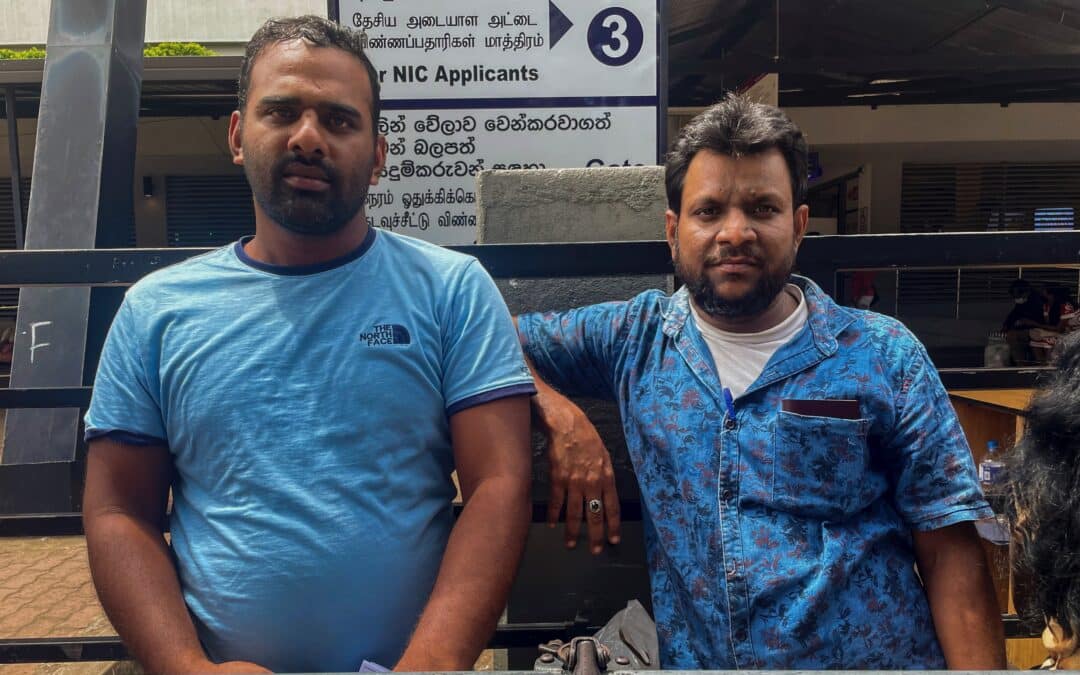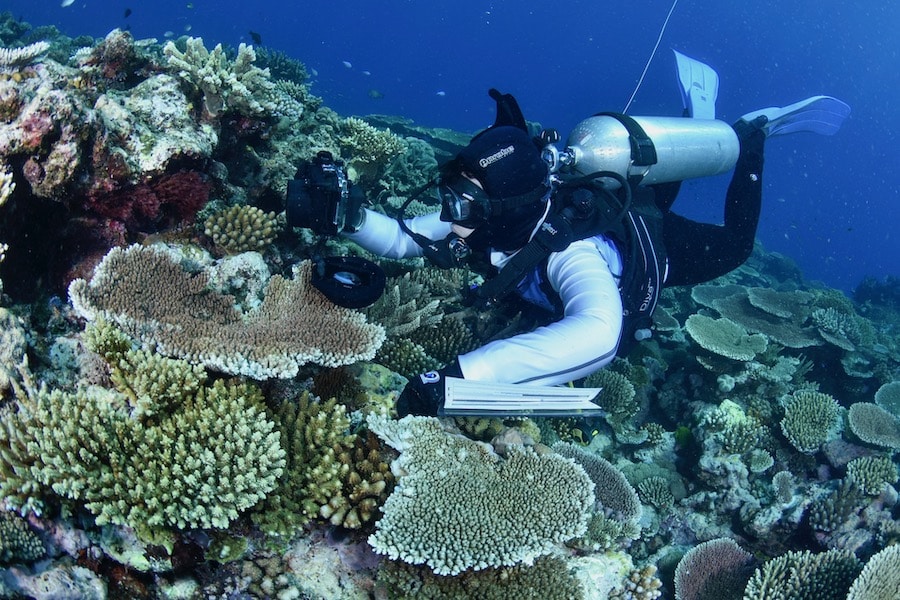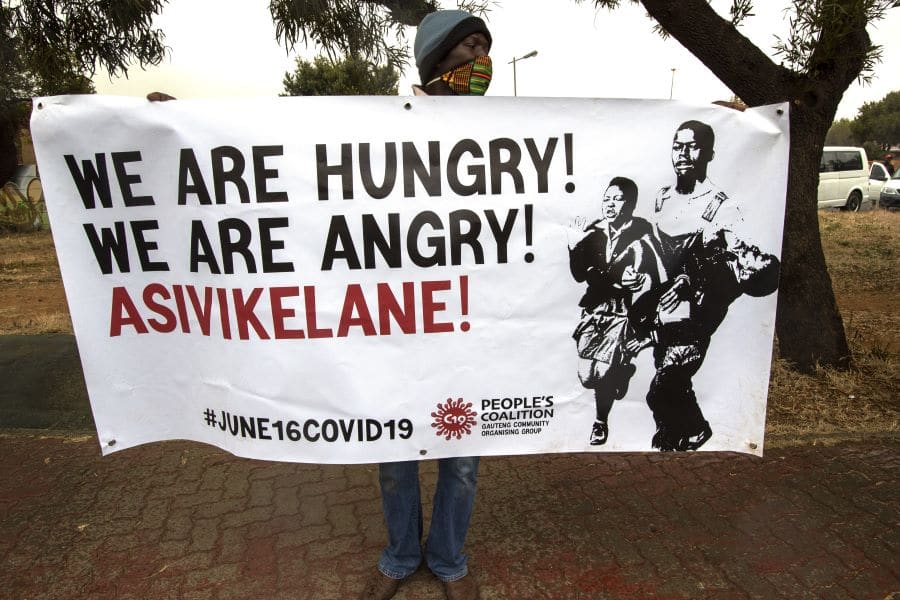
by Feizal Samath | 8 Mar 2023 | Asia, Economy
An historic number of workers are seeking work in other countries, many of them professionals. Should a nation depend on the export of its human capital? Mohamed Ishad, left, and his relative Mohamed Fahim wait outside an immigration office in Sri Lanka to get their...

by Richard Hubbard | 13 Feb 2023 | Climate decoders, Decoders, Economy, Educators' Catalog, Environment, Writing's on the Wall
The Great Barrier Reef isn’t just an endangered world wonder. Protecting the world’s largest coral reef system is also key to Australia’s economic growth. A diver swims past coral on the Great Barrier Reef in Australia, 18 October 2016. More than 90%...
Protecting the environment isn’t just the right thing to do, it can also be the profitable thing to do. Take the Great Barrier Reef, for example, which has an estimated value of $56 billion Australian dollars. Help your students disentangle the complicated world of environmental economics with this article.
Exercise: After reading the article, have students take the WWF Carbon Footprint questionnaire at https://footprint.wwf.org.uk/#/. The questionnaire estimates individuals’ carbon footprint, looking at food, travel, home and consumption habits. After the questionnaire, launch a class discussion on how changes in individual habits may contribute to fighting climate change — and might even be a profitable choice.

by Clover Choi | 10 Feb 2023 | Economy, Europe, School Year Abroad, Student Posts, Youth Voices
The Ukraine war has caused energy prices to skyrocket across Europe. In France, if costs don’t decrease soon, some bakers might have to say adieu! Baguettes in a boulangerie in Rennes, France. Credit: Clover Choi This article, by high school student Clover...

by Tiziana Barghini | 13 Jan 2023 | Economy, Educators' Catalog, World
If you owe too much money and can’t repay it, you could lose your car or home. Can a nation have too much debt? What happens then? Currencies from around the world. Getty Images. During the pandemic, businesses closed, people went into lockdown and governments...
Economic issues often confound students – and adults alike. The U.S. has hit its debt ceiling and Italy and Japan are dealing with massive amounts of national debt. But what does that mean and how does that differ from money a student’s family might owe – like a home mortgage or car loan? This month, Correspondent Tiziana Barghini decodes national debt, taking us through this complicated and timely topic.
Exercise: Give students a list of national budget expenses such as defense, food stamps, aid to public schools, road maintenance and construction, public safety etc., with percentages of the budget for each that add up to 92%. The other 8% will be interest payments on national debt. Then increase the percentage for the debt and have students try to get the overall number back to 100% by cutting spending elsewhere. As the payments on the debt go up, where will they find the money to pay it?

by Robert Holloway | 11 Jan 2023 | Economy, Educators' Catalog
The collapse of several big players last year raised questions about the survival of cryptocurrency. But let’s not dig the grave yet on digital currency. A variety of cryptocurrency tokens. Credit: Roger Brown Memo to aspiring journalists: be wary of new year’s...
There’s been some pretty scary drops in the value of some cryptocurrencies – money that only exists as computer code. Last year, for example, crypto token Terra Luna fell from about $120 to two cents in less than 48 hours, wiping out entire fortunes. In this story, correspondent Robert Holloway explains what digital currency is, why it is so volatile and why it might just last.
Exercise: Give every student a stack of “currency” with each stack labeled differently. Then on a big screen have a chart that shows the value of each slip of paper according to the color or letter. Each value will start at $1,000 so if a student has 10 slips they start off with a stack worth $10,000. Present a list of commodities they can buy at different prices. Let them see how much they can buy with their currency stack. Then change the values of the currency on the chart for different students with some going up in value and some going down in value. How does that change how much each student can buy? What does it do to their net worth? Keep changing the values so that students experience wealth and poverty depending on what value is placed on their slips of paper.

by Betty Wong | 5 Jan 2023 | Climate decoders, Economy, Educators' Catalog, Environment, Writing's on the Wall
Turn on the tap, and the world’s most valuable commodity pours out. Maybe it’s time to invest in water — to line our pockets and protect our planet. Clean water pours from a hose. Credit: Cassio Henrique. Getty Images. This article is the seventh in a...
Water is one of the most important commodities in the world. It is also tradable as companies seek to make money by purifying and distributing it. Some organizations that are pushing for climate change action are investing in water companies to pressure private industry to be better stewards of water. These investments in water stocks are proving to be financially profitable.
Exercise: The story identifies a list of companies that provide water or water infrastructure: IDEX Corp., Xylem Inc., Danaher Corp., Ecolab, Roper Industries, Pentair Plc, Ferguson Plc and American Water Works Co. Inc. Divide students into investment teams with $1 million each to invest. Have them first brainstorm ways water and systems for providing water could be improved in their area or elsewhere. Then have them look up the website of one or more of those companies to see if they can tell what the company does to improve water supply or quality. Would their $1 million invested in that company help towards the improvements they identified as needed?

by Alan Wheatley | 29 Sep 2022 | Decoders, Economy
The exchange rates of countries’ currencies such as the U.S. dollar, euro or British pound may seem obscure. But they matter a great deal to all of us. Businessman falling from pound seesaw (Ikon Images via AP Images) Even when currencies are crashing and making...

by Tira Shubart | 24 Aug 2022 | Culture, Economy
Coffee is more than a beverage in the Italian city of Trieste. Over centuries, the commodity enriched the port, where cafés are ‘places of the soul.’ Examining coffee beans at Caffè San Marco in Trieste, Italy (photo by Tira Shubart) Grabbing a coffee is...

by Stella Mapenzauswa | 11 Aug 2022 | Africa, Economy, Educators' Catalog, Politics
One out of three young Africans is unemployed, and the youth population will double by 2050. How can Africa create jobs for the young and avoid unrest? A man holds a poster marking South Africa’s Youth Day holiday in Soweto, South Africa, 16 June 2020. (AP...
Marshaling official reports and authoritative data, correspondent Stella Mapenzauswa lifts the lid on one of Africa’s biggest challenges – youth unemployment. On a continent as large and diverse as Africa, it can be perilous to generalize across borders, but Mapenzauswa puts her finger on a problem that threatens numerous governments and societies there. Not satisfied with merely identifying the problem, the experienced journalist from southern Africa glimpses a solution in “hustling” – young Africans using whatever skills they have to earn money as entrepreneurs. Some of the best journalism identifies both problems and solutions.
Exercise: Ask your students to identify a critical problem facing their local community, assessing its economic and social impact, and then to list possible solutions and the attendant costs.

by Sarah Edmonds | 27 Jul 2022 | Decoders, Economy, Educators' Catalog
Inflation is one of the biggest worries for Gen Z and Millennials. Here’s why you need to care about rising interest rates — and what you can do. A tip box is filled with dollar bills, New York, 3 April 2019. (AP Photo/Mark Lennihan) For the first time in more...
On the same day the U.S. Federal Reserve raised interest rates by another 0.75%, News Decoder correspondent Sarah Edmonds delivered a decoder breaking down an economic issue that has an impact on us all, especially young people. Using engaging and informative language, Edmonds walks the reader through the history of interest rates, how we got to the position we’re in now and what options lie ahead. In a time when nearly half of Gen Z and Millennials live paycheck to paycheck, this decoder provides concise advice for smart financial planning.
Exercise: Ask students to look up the average cost of a house and the average interest rate in the year they were born. How does that compare to today’s averages?










